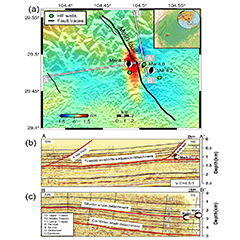Professor Hong Feng YANG at the Earth System Science Programme of The Chinese University of Hong Kong (CUHK) recently conducted a comprehensive study of the 2019 earthquake sequence in Weiyuan Shale Gas Field (WSGF) in the southern Sichuan Basin of China. It was found that the 25 February 2019 earthquake occurred at around 1 kilometer below the surface, an extremely shallow depth where earthquakes do not generally happen. There is also evidence that the earthquake was induced by the shale gas production nearby. The findings not only advance our understanding of earthquake physics, but also hold important implications for seismic hazards in shale gas fields. The research article has been published online in Seismological Research Letters.
Evidence suggests earthquake triggered by hydraulic fracturing
The earthquake occurred at 1:15 pm on 25 February 2019 and had a local magnitude (ML) of 4.9. Two foreshocks with magnitudes larger than 4 occurred nearby, around 20 and 4.5 hours before the ML 4.9 quake. These earthquakes struck Rong County, where shale gas production has been rapidly developed since 2012. To extract oil and gas from low-permeability shale rocks, hydraulic fracturing (also termed fracking), a technique of injecting high-pressure fluid to create fractures in rocks, is commonly used to increase the permeability within the reservoir. Since it has been extensively used in the shale gas industry, a significant number of earthquakes induced by fracking have been reported worldwide, including in Canada, USA, UK, and China.
The two foreshocks are found to have occurred at depths of around 2.7 kilometers, coinciding with the fracking depth. Before the main shock, fracking activities were going on at nearby injection wells. The spatial and temporal correlations suggest that these two earthquakes were induced by fracking, possibly through increasing pore pressure on the fault and thus leading to fault slip. The ML 4.9 quake, however, was constrained to a much shallower depth of 1 kilometer. Professor YANG and his collaborators at Central South University observed clear ground deformation on satellite images, which was rare for an earthquake of such magnitude but confirmed its shallow depth.



























